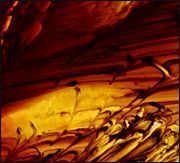Whether you accept it, avoid it or live somewhere in between, insurance coverage has become a defining issue for our profession. Patients increasingly expect to use their benefits, practitioners want to be compensated fairly for their time and expertise, and the system itself remains – at best – fragmented. The encouraging news is that coverage has expanded in meaningful ways. The challenging news is that reimbursement, across the board, remains inadequate.
Herbs & Botanicals
Amber (hu po)
What is amber? What is it used for?
Amber is technically not an herb. In fact, it's a type of resin that comes from pine trees and has been fossilized over thousands (or millions) of years. There are two main types of amber - regular amber, which is dug out of the ground, and coal amber, which is occasionally found in coal deposits. The color of amber ranges from pale yellow to red to dark brown, with a glossy, lustrous surface. Regular amber is loosely formed and rather easy to crush into a powder, while coal amber is hard in texture and more difficult to break. Both types of amber are used in herbal medicines, and are ground into powders for different formulas.
According to the principles of traditional Chinese medicine, amber has sweet and neutral properties, and is associated with the Bladder, Heart and Liver meridians. Its functions are to calm the spirit and invigorate the blood.
 Amber is used for a variety of ailments. As a tonic, it is used to treat anxiety, tremors, seizures and insomnia, and to calm the mind and promote restful, dreamless sleep. It improves the flow of blood and urine, and can treat conditions such as anemorrhea. Amber can also be applied topically to treat sores, carbuncles and skin ulcers.
Amber is used for a variety of ailments. As a tonic, it is used to treat anxiety, tremors, seizures and insomnia, and to calm the mind and promote restful, dreamless sleep. It improves the flow of blood and urine, and can treat conditions such as anemorrhea. Amber can also be applied topically to treat sores, carbuncles and skin ulcers.
How much amber should I take?
The recommended daily dosage of amber is between 0.9 and 3 grams, either as a powder or pill. Amber should not be used as a decoction. Larger amounts can be used when applying amber to the skin.
What forms of amber are available?
Amber is available as a pill, powder or capsule. It is not to be used in decoctions.
What can happen if I take too much amber? Are there any interactions I should be aware of? What precautions should I take?
Although amber is considered extremely safe, and there are no known side-effects from taking large doses, it should not be given to patients with excess heat or yin deficiency. As of this writing, there are no known drug interaction with amber. As always, make sure to consult with a license health care professional before taking amber or any other herbal remedy or dietary supplement.
References
- Dharmananda S. Abdominal adhesions: prevention and treatment. Institute for Traditional Chinese Medicine Web site, May 2003. www.itmonline.org/arts/adhesions.htm
- Dharmananda S. Treatment of interstitial cystitis with Chinese medicine. Institute for Traditional Chinese Medicine Web site, May 2003. Available at www.itmonline.org/arts/cystitis.htm.
- Teeguarden R. Radiant Health: The Ancient Wisdom of the Chinese Tonic Herbs. New York: Warner Books, 1998, p. 200.
- Wang DZ, Wang ZQ, Zhang ZF. Study on the treatment of endometriosis with removing blood-stasis and purgation method. Chinese Journal of Integrated Traditional and Western Medicine 1991;11(9):524-526.
- Yuan J, et al. 116 cases of coronary angina pectoris treated with powder composed of radix ginseng, radix notoginseng and succinum. J Tradit Chin Med March 1997;17(1):14-7.


